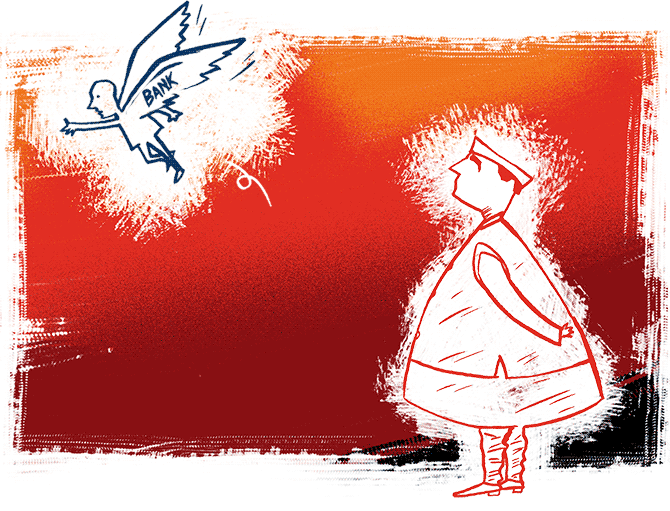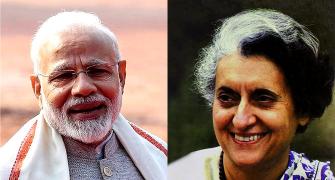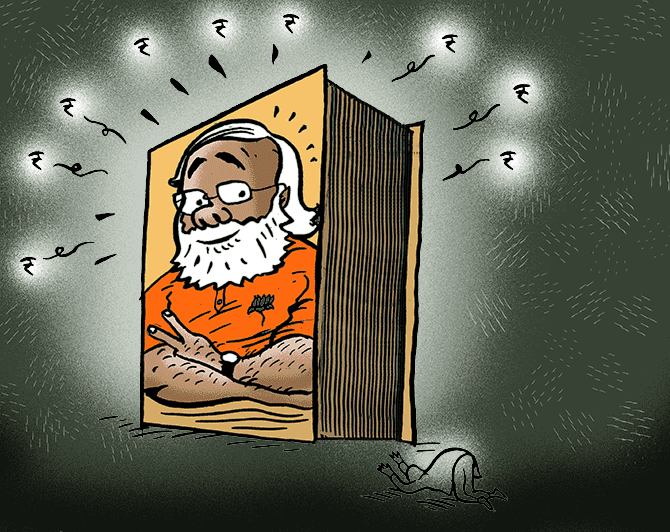'The market may take time to digest this merger but it could be a template for the next four mergers for creating mega banks,' says Tamal Bandyopadhyay.
Illustration: Dominic Xavier/Rediff.com

On June 9, around 2,000 Bank of Baroda (BoB) employees participated in a five-km “Su Run”, flagged off by badminton champion Srikanth Kidambi at Jio Garden, Mumbai’s Bandra Kurla Complex, where the bank is headquartered.
That was one of the many segments of a team-building exercise, which will be replicated in other cities.
The sports culture is an import from Vijaya Bank which, along with Dena Bank, has been merged with BoB -- the first such instance in the history of India’s public sector banks (PSBs).
Indeed, New Bank of India was merged with Punjab National Bank in 1993, but the context of that merger was different.
The associate banks of the State Bank of India (SBI) got merged with the parent in 2017 for the sake of consolidation -- a family affair. (Bharatiya Mahila Bank too got merged with the SBI but it was too small an entity.)
Emboldened by the BoB experiment, the government has recently announced the merger of 10 PSBs into four mega “NextGen” banks to boost credit in Asia’s third largest economy that aspires to reach the $ 5 trillion mark by 2025.
Cricketers Anil Kumble and Javagal Srinath, athlete Ashwini Nachappa, among others, were on Vijaya’s payroll which excelled in basketball, kabaddi and cricket.
BoB wants to imbibe that culture.
To preserve the legacy of Vijaya and Dena, it is also creating museums in Bangalore and Mumbai, respectively, on the lines of its own museum in Baroda.
These are some of the softer aspects of the merger of 88-year old Vijaya and 81 year old Dena with 111 year old BoB.
It is done but not dusted as yet and the completion of the process could extend to December 2020.
On September 17, 2018, the merger was announced.
After the boards of the three banks cleared the proposal, the government approved it on January 2, 2019.
For fair valuation, the three balance sheets were scrutinised to check the provisions made for the retirement benefits of 85,000 employees, bad assets (already identified and/or hidden) and the uniformity of accounting policies.
For instance, the same asset could have been good on one bank’s book and bad on the other's; also, one bank could have made provision even for non-fund based exposure while another had not.
To harmonise the accounting practices, at least Rs 6,000 crore extra capital was needed.
The government stepped in with Rs 5,042 crore and has promised to infuse another Rs 7,000 crore.
Dena shareholders received 110 shares of BoB for every 1,000 shares they held; for Vijaya shareholders, 402 for every 1,000 shares.
Since the BoB share has a face value of Rs 2 and the other two Rs 10, the discount was rather steep.
No one complained as the swap ratios largely reflected the market price of the shares of the three banks.
How is the merger being executed?
Since the boards cleared the proposal, there have been at least 100 town hall meetings.
The three CEOs -- PS Jayakumar of BoB (who has been driving it), R A Sankara Narayanan of Vijaya (who later moved to head Canara Bank) and Karnam Sekar of Dena (now heading Indian Overseas Bank) -- together addressed one-fifth of them.
Then, there is the “pulse check” exercise -- a survey of the employees’ reaction to the merger, done anonymously -- devised by management consulting firm BCG.
Till now, two such surveys have gauged the employee happiness quotient and noted their suggestions on the merger.
To make it a smooth affair, “buddy branches” have been created: One BoB branch is linked to two branches of Vijaya and Dena to create camaraderie and understanding of the BoB way of doing business by the other two.
This has been supplemented by “utsuk” training.
At the BoB training centres, Vijaya and Dena employees have been continuously exposed to its policies and processes.
Till the merger was formally consummated, the three CEOs were jointly writing the emails to all employees.
Even though they have lost their clout, the trade unions have been actively engaged in the process.
That out of 15 chief general managers in the merged entity, three each have been chosen from Dena and Vijaya and out of 85,000 employees, only 240 are not continuing with the merged entity, say a lot about the care taken on the HR front.
Roughly 10 per cent of the 9,500 branches of the new BoB will be relocated or merged with the others to avoid overlaps; around 540 of them have already been identified.
These are logistics issues.
For insights and inputs, many experts are engaged at the board and its various committees; they are not directors but attend such meetings by invitation.
The toughest part in any bank merger is technology.
While all three have been using Finacle, a core banking product of Infosys Ltd, BoB has Finacle-10 while Vijaya and Dena have been using Finacle-7, that too two different versions, customised for each bank.
In the first stage, there is inter-operability of three different tech platforms for six basic banking services - cash withdrawal, deposit, transfer of funds, balance enquiry, mini statement and stop payment instructions.
Also, the entire corporate business of Dena and Vijaya, about 47 per cent of their loan books, has been shifted to the BoB platform.
Now, the merged entity is following a “branch in branch” concept: In 1,000 Vijaya and Dena branches, there is a BoB desk to create all new businesses on its platform.
What are the benefits of the merger? In five states -- Rajasthan, Uttar Pradesh, Karnataka, Gujarat and Maharashtra -- BoB’s market share in business has risen 10 per cent.
Over the next five years, at least Rs 9,500 crore will be generated through the sale of non-productive real estate, besides the other benefits arising out of business synergy.
The low-cost current and savings account as a portion of the overall deposits is rising, so does the provision coverage ratio while the cost of income ratio is coming down.
These are good omens but the market doesn’t seem to be convinced as yet.
The combined market cap of the three entities on the day the merger was announced was close to Rs 48,000 crore.
That has slipped close to 25 per cent while Bank Nifty has risen.
The market may take time to digest this merger but it could be a template for the next four mergers for creating mega banks.
Tamal Bandyopadhyay, a consulting editor of Business Standard, is an author and senior adviser to Jana Small Finance Bank Ltd.









